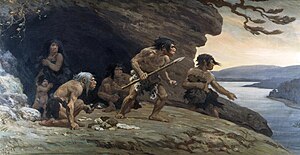Caveman

The caveman is a
The term "caveman" has its
Characteristics

Cavemen are typically portrayed as wearing shaggy
The image of these people living in caves arises from the fact that caves are where the preponderance of
Stereotypical cavemen have traditionally been depicted wearing smock-like garments made from the skins of animals and held up by a shoulder strap on one side. Stereotypical cavewomen are similarly depicted, but sometimes with slimmer proportions and bones tied up in their hair. They are also depicted carrying large clubs approximately conical in shape. They often have grunt-like names, such as Ugg and Zog.[6]
History

Caveman-like heraldic "wild men" were found in European and African iconography for hundreds of years. During the Middle Ages, these beings were generally depicted in art and literature as bearded and covered in hair, and often wielding clubs and dwelling in caves. While wild men were always depicted as living outside of civilization, there was an ongoing debate as to whether they were human or non-human.
In Sir
Griffith's Brute Force represents one of the earliest portrayals of cavemen and dinosaurs together, with its depiction of a
See also
- Cave dweller
- Cavewoman, a 1993-2009 American comic book series
- Cavegirl, a 2002-03 British TV series
- Walking with Cavemen, 2003 documentary miniseries
- Dawn of Humanity, 2015 PBS film
- Man cave
- Neanderthals in popular culture
- Prehistoric fiction
- Troglodyte (disambiguation)
- Wild man
References
- ^ "Ape-like or human? Disagreement erupts over Neanderthal posture". Cosmos. 25 February 2019. Archived from the original on 2020-08-13. Retrieved 2020-04-13.
- ISSN 1476-4687.
- Nautilus. Retrieved 2020-04-13.
- ^ Jerry D. Moore, "The Prehistory of Home", University of California Press, 2012
- ^ "Carmel Caves - How to meet a caveman - Israel Guide - Jerusalem Post". www.jpost.com. Retrieved 2019-10-18.
- ^ "Contents Page: 82". www.depauw.edu. Retrieved 2019-05-08.
- ^ Stills from Man's Genesis Archived 2008-07-20 at the Wayback Machine and His Prehistoric Past show that Chaplin still has his bowler hat.
- ^ Rebecca Hawkes (24 November 2015). "Costumed pigs, iguanas and Raquel Welch: the evolution of movie dinosaurs". The Telegraph. Archived from the original on 2022-01-12. Retrieved 15 May 2020.
- ^ ISBN 978-0-253-33349-0.
- ISBN 0-8362-1851-5.
- ^ Blake, Heidi (30 September 2010). "The Flintstones' 50th anniversary: 10 wackiest Bedrock inventions". Daily Telegraph. Archived from the original on 2022-01-12.
External links
- Apes as Human at The Encyclopedia of Science Fiction
- Cavemen at Comic Vine
- Origin of Man at The Encyclopedia of Science Fiction
